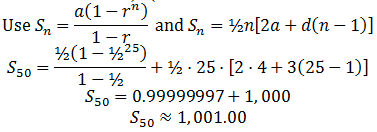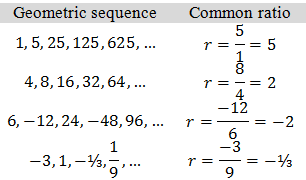Geometric Sequence Problems
Problems of growth and decay involve repeated multiplications by a constant number. Therefore, we can use geometric sequences to model these situations.
We studied exponential functions of the form f(x)=bx, exponential functions can be used to model some growth examples in this page. Because a geometric sequence is an exponential function whose domain is the set of positive integers, geometric and exponential growth mean the same thing.
Geometric Population Growth

Economist Thomas Malthus (1766-1834) predicted that population would increase as a geometric sequence and food production would increase as an arithmetic sequence. He concluded that eventually population would exceed food production. If two sequences one geometric and one arithmetic, are increasing, the geometric sequence will eventually overtake the arithmetic sequence, regardless of any head start that the arithmetic sequence might initially have.
📌 Example 1: Geometric Population Growth
The table shows the population of the United States in 2000, with estimates given by the Census Bureau for 2001 through 2006.

a. Show that the population is increasing geometrically.
b. Write the general term for the geometric sequence modeling the population of the United States, in millions, n years after 1999.
c. Project the U.S. population, in millions, for the year 2009.
✍ Solution
a. First, we use the sequence of population growth, 281.4, 284.5, 287.6, 290.8, and so on, to divide the population for each year by the population in the preceding year.

Continuing in this manner, we will keep getting approximately 1.011. This means that the population is increasing geometrically with r≈1.011. The population of the United States in any year shown in the sequence is approximately 1.011 times the population the year before.
b. The sequence of the U.S. population growth is
Because the population is increasing geometrically, we can find the general term of this sequence using
In this sequence, a1=281.4 and [from part (a)] r≈1.011. We substitute these Values into the formula for the general term. This gives the general term for the geometric sequence modeling the U.S. population, in millions, n years after 1999.
c. We can use the formula for the general term, an, in part (b) to project the U.S. population for the year 2009. The year 2009 is 10 years after 1999— that is, 2009-1999=10. Thus, n=10. We substitute 10 for n in an=281.4(1.011)n-1.
The model projects that the United States will have a population of approximately 310.5 million in the year 2009.
📌 Ex2. The population of a town increases at the rate of 10% annually. Its present population is 200,000 what will be its population at the end of 5 years?
✍ Solution:
Let, present population =a=200,000 (given)
The increase of population at the end of 1st year
Total population at the end of 1st year =a+a(0.1)=a(1.1)
Total population at the end of 2nd year =a(1.1)(1.1)=a(1.1)2
The population at the end of 5 years is the 6th terms of G.P
Here a=200,000 , r=1.1, n=6, a6=?
Since, an=a⋅rn-1
📌 Ex3: Using a Geometric Sequence to Solve a Problem
The population of Airdrie, Alberta, experienced an average annual growth rate of about 9% from 2001 to 2006. The population in 2006 was 28,927. Estimate the population in each year to the nearest thousand.
a) 2011
b) 2030, the 125th anniversary of Alberta becoming part of Canada What assumption did you make? Is this assumption reasonable?
✍ Solution:
a) A growth rate of 9% means that each year the population increases
by 9%, or 0.09.
The population in 2006 was 28,927.
So, the population in 2007 was: 28,927 + 9% of 28 927
=28,927+0.09(28,927). Remove 28,927 as a common factor.
=28,927(1+0.09)
=28,927(1.09)
Increasing a quantity by 9% is the same as multiplying it by 1.09. So, to determine a population with a growth rate of 9%, multiply the current population by 1.09.
The annual populations form a geometric sequence with 1st term 28 927 and common ratio 1.09.
The population in 2006 is the 1st term. So, the population in 2011 is the 6th term: 28,927(1.09)5=44,507.7751…
The population in 2011 is approximately 45,000.
b) To predict the population in 2030, determine n, the number of years from 2006 to 2030:
n=24
The population in 2030 is: 28 927(1.09)24=228,843.903…
The population in 2030 will be approximately 229,000.
We assume that the population increase of 9% annually continues. This assumption may be false because the rate of growth may change in future years. This assumption is reasonable for a short time span, but not for a longer time span, such as 100 years.
📌 Ex4. The initial population of rabbits on a farm was 50.
The population increased by 7% each week.
a) How many rabbits were present after: (i) 15 weeks (ii) 30 weeks?
b) How long would it take for the population to reach 500?
✍ Solution:
There is a fixed percentage increase each week, so the population forms a geometric sequence.
u1=50 and r=1.07
u2=50×1.071= the population after 1 week
u3=50×1.072= the population after 2 weeks
un+1=50×1.07n= the population after n weeks.
a) (i) u16=50×1.0715≈137.95. There were 138 rabbits.
(ii) u31=50×1.0730≈380.61. There were 381 rabbits.
b) We need to solve 550×1.07n=500

or trial and error on your calculator gives n≈34 weeks.
The population will reach 500 early in the 35th week.
📌 Ex5. X GAMES Refer to the beginning of the lesson. The X Games netted approximately $40 million in revenue in 2012. If the X Games continue to generate 13% more revenue each year, how much revenue will the X Games generate in 2030?
✍ Solution:
The X Games netted about $40,000,000 in 2012, so a1=$40,000,000. Because the games generate 13% or 0.13 more revenue each year, the amount of revenue generated on a given year will be 1.13 times the revenue from the previous year. So, r=1.13. The first term a1 corresponds to the year 2012, so the year 2030 corresponds to a19.
Use the formula for the nth term of a geometric sequence to find the a19.
a19=40,000,000⋅(1.13)19-1
a19=360,970,718.60.
Therefore, the X Games will generate about $360.97 million in 2030.
📌 Ex6. (Horses) For each of the first few months after a horse is born, the amount of weight that it gains is about 120% of the previous month’s weight gain. In the first month, a horse has gained 30 pounds.
a. Write a geometric series in sigma notation that can be used to model the horses weight gain for the first five months.
b. About how much weight did the horse gain in the fourth month?
c. If the horse weighed 150 pounds at birth, about how much did it weigh after 5 months?
d. Will the horse continue to grow at this rate indefinitely? Explain.
✍ Solution:
a. The amount of weight that a horse gains is 120% of the previous months weight gain, so r=1.2. Because the horse gained 30 pounds in the first month, a1=30.
Write an explicit formula for the horse’s weight gain.
=30⋅(1.2)n-1.
The lower bound is 1 and the upper bound is 5. Therefore, in sigma notation the series representing the horses weight gain for the first five months can
be written as ∑5n=1 30⋅(1.2)(n-1).
b. Use the explicit formula you found in part (a.) to find a4.
a4=30⋅(1.2)4-1
a4=51.84.
Therefore, in the fourth month the horse gained 51.84 pounds.
c. First, find the sum of the series.

Because the horse weighed 150 pounds at birth, after 5 months the horse weighed 223.248+150 or about 373.248 pounds.
d. Sample answer: No; the horse cannot continue to grow at this rate indefinitely because its body will eventually stop growing.
📌 Ex7. (CCSS Reasoning) At an online mapping site, Mr. Mosley notices that when he clicks a spot on the map, the map zooms in on that spot. The magnification increases by 20% each time.
a. Write a formula for the nth term of the geometric sequence that represents the magnification of each zoom level. (Hint: The common ratio is not just 0.2.)
b. What is the fourth term of this sequence? What does it represent?
✍ Solution:
a. Because the magnification increases by 20% with each click, the total magnification after each click is 120%. The common ratio is 1.2. To find the nth term of the geometric sequence that represents the magnification of each zoom level, use the formula (1.2)n.
b.
(1.2)4=2.0736.
The fourth term of the sequence is 2.0736. It represents the magnification after the fourth click. So, the map will be magnified at approximately 207% of the original size after the fourth click.
💎 Let’s read post •Depreciation or Decay👈.





